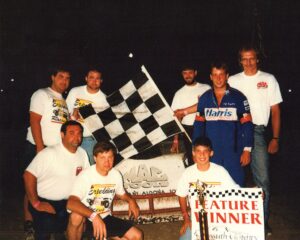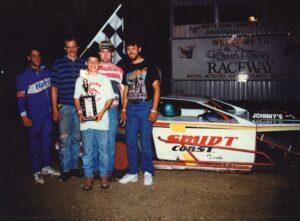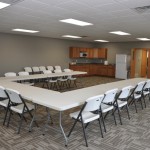By Chad Meyer
The inscription on Myron Carlson’s hall of fame plaque will say mechanic, but his value to three drivers that he joins in the Kossuth County Racing Hall of Fame go far beyond just spinning wrenches. A more accurate description should include the words “creator,” “fabricator,” and “innovator.”
“When I was in high school, I had a street car that we worked on, adding a four-barrel carb and the like,” Carlson said when asked about his early interest in motorsports. “I became a welder and fab guy and also drag raced motorcycles some, altering the swing arm to make them faster.”
 Carlson’s interest in local dirt track racing was accelerated when the Kossuth County Speedway reopened in 1986 after being closed for the 10 years prior. “I had a portable stick welder that I brought to the track and helped anybody that needed it. I was friends with Dave Erpelding and he had a car. It had a single leaf spring suspension and the left side broke. I helped fixed it that Saturday night and Dave said the car worked better after that. The next night he won his first race at Mason City with changes we made to the car.”
Carlson’s interest in local dirt track racing was accelerated when the Kossuth County Speedway reopened in 1986 after being closed for the 10 years prior. “I had a portable stick welder that I brought to the track and helped anybody that needed it. I was friends with Dave Erpelding and he had a car. It had a single leaf spring suspension and the left side broke. I helped fixed it that Saturday night and Dave said the car worked better after that. The next night he won his first race at Mason City with changes we made to the car.”
In 1989, Dave Erpelding, with Carlson’s help, made the jump to an IMCA Modified and what a season it was. “We had the car working really well. By the end of the season, he was the 1989 IMCA Modified Rookie of the Year and had a few wins,” says Carlson. “We finished fourth at [IMCA’s] Supernationals that year, too.”
Remarkably, Dave Erpelding’s first ever IMCA modified win came in the IMCA National Modified Series “Tour of the Northlands” event at the I-35 Speedway in Mason City in June of ‘89. Erpelding led the final 17 laps and he earned it by holding off a determined charge put forth by Kelly Shryock in the final laps. In August of that year, Erpelding’s hot rookie year continued, sweeping a 44-car field at another IMCA Modified Nationals event, this one at the Buena Vista Raceway in Alta, IA. He claimed one of the six heat race wins, the trophy dash and ran away from a fast field, overtaking Denny Hovinga in the 30-lapper.
 Carlson remembers, “We were running down the leaders at the IMCA Nationals race at Fairmont, too, and had a chance to win. But the engine blew and that was it.”
Carlson remembers, “We were running down the leaders at the IMCA Nationals race at Fairmont, too, and had a chance to win. But the engine blew and that was it.”
After 1989, Dave Erpelding retired from racing, at least for the first time. Lending a hand to Doug Wildin and his cousin Mike Carlson, Myron stayed connected to the local racing scene.
“In 1994, I started with Tim Erpelding and by mid-season we had the car working better. In 1995 we won some races and secured the [IMCA Modified] point title,” Carlson said.
After Tim Erpelding stopped racing 1997, he got connected with Steve Krapp and Denny Anderson, ultimately forming what became known as Anderson South Racing.
“Denny had a new car and we chatted the winter of 1998. I told Denny that if he left a car down here in Algona for us to maintain, I’d guarantee we’d win the point championship,” said Carlson.
That bit of bravado was backed up by Carlson’s meticulous attention to detail. “I beefed up the suspension and made it heavier for racing on a short track. You got to finish races to be a champion and that’s what we did. We only won one race at Algona that year, but it seemed like we were in the top four 85% of the time,” Carlson recalls.
Anderson South Racing won the point title at Algona in 1998 and finished second in the title chase in 1999.
Carlson was an innovator that helped not only the teams he was affiliated with, but others. Among innovations that Carlson created, including a longer piston for Tilton’s hydraulic throw-out bearing that Tilton itself later manufactured itself, he came up with an easier way to adjust the pinion angle in IMCA Modifieds.
“In 1994, when I was with Tim [Erpelding], we were running a Harris car. It was a pain to adjust the pinon angle of the rear end, jacking the car up and down to get it done. I came up with our own pinon angle adjuster that made it so much easier to do. I took it to [Story City] to Harris Auto Racing and showed Wayne Redmond what I built. By the time I left, Kelly Shryock said he wanted one and soon after I was building them for Harris,” he said.
In 2000, Carlson became shop foreman at the Kossuth County Road Department shop and he knew it was time to slow down from racing. “I’d work 10-hour days and work on the race car every night, then race all weekend and wash the car on Sunday. I did almost everything except build the chassis. I even lettered the car,” Carlson remembered. “It was time to step away.”
Carlson says he is most proud of when the work put in translated to success on the track. “It was a lot of work, but was a lot of fun when the car worked well. I remember winning a heat race and crews would come by trying to figure out how we did it. My reply was that you’re not going to find it here,” Carlson laughed.
“Winning races was fun, and the championships made it worthwhile. I’m probably the only crew guy that ever made a little money doing it, too. Denny [Anderson] paid me 25% of what the car took in. It probably wasn’t a lot of money, but it paid my pit pass and bought me a couple of beers,” he said.
Today, Carlson is retired and lives in Algona.
